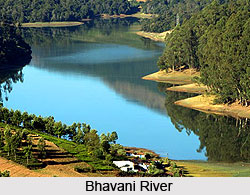 A major tributary of the Cauvery River is the Bhavani River, which is the second largest river in Tamil Nadu. The river is two hundred and seventeen kilometers long and flows through the states of Kerala and Tamil Nadu. The drainage basin of this perennial river is spread over an area of 6,200 square kilometers, out of which, eighty seven percent is in Tamil Nadu, nine percent in Kerala and four percent in Karnataka. The river mainly flows through Coimbatore and Erode districts of Tamil Nadu. The major towns situated on the banks of the river are Mukkali, Athikadavu, Koodappatti, Mettupalayam, Bhavanisagar, Sathyamangalam,Aapakudal, Gobichettipalayam, Aavudaiaaparai, Bhavani.
A major tributary of the Cauvery River is the Bhavani River, which is the second largest river in Tamil Nadu. The river is two hundred and seventeen kilometers long and flows through the states of Kerala and Tamil Nadu. The drainage basin of this perennial river is spread over an area of 6,200 square kilometers, out of which, eighty seven percent is in Tamil Nadu, nine percent in Kerala and four percent in Karnataka. The river mainly flows through Coimbatore and Erode districts of Tamil Nadu. The major towns situated on the banks of the river are Mukkali, Athikadavu, Koodappatti, Mettupalayam, Bhavanisagar, Sathyamangalam,Aapakudal, Gobichettipalayam, Aavudaiaaparai, Bhavani.
Bhavani River originates in the upper regions of the Nilgiris of the Western Ghats. It is joined by twelve rivulets, which drain the southern Nilgiri slopes. The largest tributaries of the Bhavani River are West and East Varagar, which come from the Nilgiris. It is at Mukkali, Bhavani turns in the northeast direction and flows through Attappady plateau for twenty five kilometers and seven kilometers along the inter state border. The Kunda River coming from the north joins the Bhavani River in western Tamil Nadu at Athikadavu. The Bhavani is joined by Siruvani River of Coimbatore district and Kodungarapallam River at Koodappatti on the Kerala-Tamil border. The river then flows in the east direction along the base of Nilgiris. It enters the plains near Mettupalayam near Bathra - Kaliaman Temple where the Coonoor River coming from Coonoor joins Bhavani.
The river moves in the east direction at a distance of 160 kilometers through Erode district cutting across the taluks of Gobichettipalayam and Bhavani before joining the Cauvery in the town of Bhavani. Bhavani Sangameshwarar Temple, situated at the meeting point of Bhavani and the Cauvery Rivers, is a prominent pilgrim center.
Bhavani Sagar Dam is a tourist spot across this river. The river flows near Mettupalam, which is a prominent town and gateway to the hill station Ooty.



















